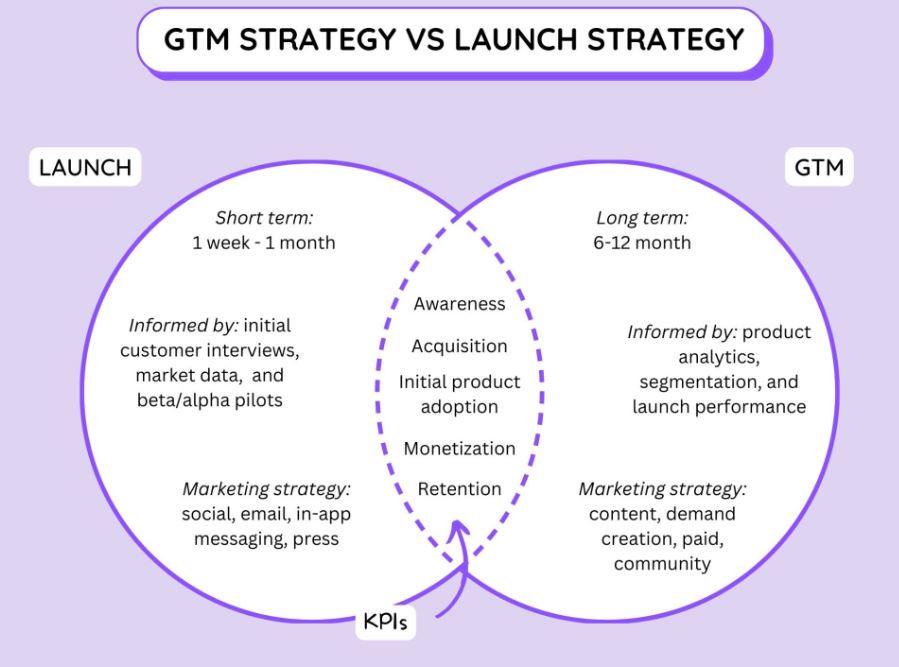Demystifying GTM: Going beyond the Launch

In the fast-paced realm of product development and marketing, the distinction between a launch strategy and a go-to-market (GTM) strategy can often be blurred. However, understanding the nuances between the two is crucial for effectively bringing new products to market and achieving sustained success. Let’s dive into the key differences and explore why GTM strategy is not just a launch strategy, but a continuous journey of refinement and adaptation.
Launch Strategy: Beyond buzz, eyeballs and baits
A launch strategy is essentially the grand unveiling of a new product, aimed at capturing the attention of the target audience and guiding them through the customer journey. While it does cover aspects of awareness and acquisition, it goes beyond buzz generation, eyeballs and clickbait. Launches demand meticulous segmentation, personalized messaging, and a seamless experience from initial engagement to product adoption. The success of a launch hinges on attracting the right audience and delivering a compelling experience that resonates with their needs and preferences. However, a successful launch does not guarantee sustained success—it just marks the beginning of the journey.
GTM Strategy: No gimmicks, all grind
So while a launch strategy focuses on initial execution, a GTM strategy takes a more iterative and adaptive approach. No flashy gimmicks here, its all about the grind and tweaking your approach based on real-world feedback. While hypotheses about market positioning and audience engagement may be formulated beforehand, the reality often differs post-launch. A GTM strategy should reflect the product’s success in the market and continually evolve based on real-world feedback and data insights. It’s not uncommon for initial launches to fall flat due to a lack of product-market fit. In such cases, it’s imperative to reassess and pivot accordingly, addressing underlying product issues before doubling down on marketing efforts. The market moves fast, and if you aren’t keeping up, you’ll be left in the dust.
Establishing Product-Market Fit
You can have the slickest campaign in the world, but if your product isn’t hitting the mark, you’re in trouble. One of the primary objectives of a GTM strategy is to establish product-market fit (PMF)—the alignment between the product offering and the target market’s needs. Without PMF, even the most robust marketing efforts are destined to fail. It’s essential to leverage product analytics to gauge adoption, retention, and monetization metrics accurately.
Identifying Growth Strategies
Additionally, the choice of growth strategy—whether product-led, sales-led, or marketing-led—plays a pivotal role in shaping the GTM approach. Each strategy requires a tailored approach to audience segmentation, messaging, and channel selection, reflecting the unique dynamics of the market and product offering.
Pro Tips for Crafting a Successful GTM Strategy
- Segmentation is Key: Dive deep into your target audience and personalize the user and buyer journey for each persona.
- Data-Driven Decision-Making: Wait until you have initial data to gain insights into what’s working and what’s not before making strategic adjustments.
- Iterate and Refine: Embrace a mindset of continuous improvement, iterating on your GTM strategy based on real-world feedback and market dynamics.
From Launch mindset to Growth Mindset
While a launch strategy marks the initial introduction of a product to the market, a GTM strategy represents an ongoing journey of refinement, adaptation, and growth. By understanding the distinct roles and objectives of each strategy and embracing a data-driven and iterative approach, organizations can navigate the complexities of bringing new products to market and drive long-term success. Remember, the journey doesn’t end at launch—it’s just the beginning of an exciting adventure towards market dominance and customer delight.


Leave a Reply